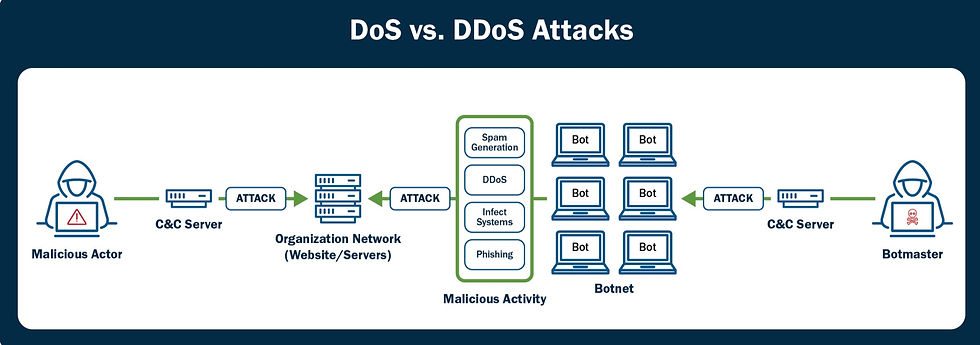Protecting Your Cannabis Club from DDoS Attacks
- Kev

- Mar 25, 2024
- 3 min read
Distributed Denial-of-Service (DDoS) attacks represent a significant threat to the digital infrastructure of businesses worldwide, including the burgeoning cannabis industry. As cannabis clubs and dispensaries increasingly rely on online platforms for sales, customer engagement, and supply chain management, the need for robust cybersecurity measures has never been more critical. This article provides a detailed guide on understanding DDoS attacks and implementing effective strategies to protect your cannabis club from such threats.

Understanding DDoS Attacks
At their core, DDoS attacks aim to disrupt the normal functioning of a targeted server, service, or network by overwhelming it with a flood of internet traffic. These attacks can originate from multiple compromised computer systems, making them particularly challenging to defend against.
Key Differences: DoS vs. DDoS
DoS Attack: Involves a single source overwhelming a target with excessive traffic.
DDoS Attack: Utilizes multiple sources or a botnet to launch a more extensive and challenging to mitigate attack.
DDoS attacks are categorized into three main types based on their approach:
Volume-Based Attacks: Aim to consume all available bandwidth with a flood of data.
Protocol-Based Attacks: Exploit weaknesses in the network's protocols to disrupt communication.
Application Layer Attacks: Target specific applications or services to overload them with requests.
Preemptive Measures
To safeguard your cannabis club's digital assets, proactive steps are essential:
Conduct Risk Assessments: Regularly evaluate your network for vulnerabilities.
Enhance Network Monitoring: Utilize advanced monitoring tools to detect unusual traffic patterns.
Implement Traffic Analysis: Establish a baseline of normal traffic to spot deviations.
Adopt DDoS Mitigation Services: Consider third-party services specialized in mitigating DDoS threats.
Increase Bandwidth: Ensure your network can handle sudden spikes in traffic.
Utilize Load Balancers: Distribute traffic evenly to prevent overload on any single server.
Firewall Configuration: Set up rules to filter suspicious traffic and block known malicious IP addresses.
Recognizing a DDoS Attack
Identifying a DDoS attack early is crucial for minimizing its impact. Signs include:
Sudden unavailability or slowdown of your website.
Unexplained network congestion.
A significant increase in traffic from specific IP addresses.
Unexpected crashes or unresponsiveness in servers or applications.
Effective Response Strategies
Upon detecting a DDoS attack, immediate action is required:
Activate Your Incident Response Plan: Ensure your team knows their roles and responsibilities.
Engage with ISPs: Inform your service providers to seek assistance in traffic rerouting or filtering.
Traffic Filtering: Implement measures to block malicious traffic while allowing legitimate users access.
Leverage DDoS Mitigation Services: Activate any pre-arranged DDoS protection services.
Communication is Key: Keep stakeholders informed about the situation and expected resolution timelines.
Post-Attack Recovery
Recovering from a DDoS attack involves several critical steps:
Assess the Damage: Evaluate the impact on your services and infrastructure.
Restore Services: Work to bring affected systems back online.
Analyze the Attack: Understand the attack vectors used to improve future defenses.
Review and Update Security Measures: Adjust your security posture based on lessons learned.
Educate Your Team: Ensure your staff is aware of the signs of DDoS attacks and the proper response protocols.
Continuous Improvement
The threat landscape is constantly evolving, requiring businesses to stay vigilant and adapt their cybersecurity strategies accordingly. Regularly updating your defense mechanisms, training your team, and staying informed about the latest DDoS attack trends are crucial for maintaining a secure online presence for your cannabis club.
By understanding the nature of DDoS attacks and implementing a comprehensive defense strategy, cannabis clubs can protect their digital assets and ensure uninterrupted service to their customers.








コメント